Pork Yield and Quality and Pork Carcass Evaluation
1/51
There's no tags or description
Looks like no tags are added yet.
Name | Mastery | Learn | Test | Matching | Spaced |
|---|
No study sessions yet.
52 Terms
Key factors impacting pork yield and quality
Genetics, Nutrition, environment
Genetics
Genotype
Genetic makeup of animal
Combined from sire and dam
Phenotype
Observable characteristics
Influenced by both genotype and environment
P=G+E
Qualitative Traits
Controlled by few pairs of genes
Phenotypes are easily distinguished
No environmental effect on phenotype
No economic relevance in traits
Exception: Show pigs
Quantitative Traits
Controlled by hundreds or thousands of genes
Most econmically relevant traits
Environment affects expression
Ex. Days to 250, litter size, backfat, muscling
Heritability
Terminal traits are typically more than 30%
Days to 250-35%
Feed efficiency-30%
Backfat thickness-40%
How to improve terminal traits?
Selecting a boar that excels in these traits
Breeding value
Value of animal as genetic parents
Estimated Breeding Value (EBV)
Estimate of genotypic value an individual possesses
Expected progeny difference (EPD)
Advantage or disadvantage of an individual’s offspring over the progeny of an average animal
Positively Correlated Traits
Positive: When an increasse in one trait is made, the other trait increases as well
LEA to % lean
Negatively Correlated Traits
When an increase in one trait is made, the other trait decreases, greater muscle to poorer maternal performance
What traits should be selected?
Econmically relevant traits
Number born alive
Days to market weight
Backfat
Loin eye area
Most econmical cereal grain
Corn
Sorghum
Wheat
Barley
Oats
Good quality protein sources
Soybean meal
Canola meal
Other oilseed-based meals
Corn
Most used (most economical)
Palatable and high energy density
Low protein content, poor AA profile
Deficient in lysine, tryptophan, threonine, and others
How to maximize cereal grain feeding value?
Ground or rolled, improves feed conversion
Protein
Soybean meal
Co-product of oil production
Low fat content
“Gold Standard” of high quality protein for pigs
AA profile complements that of cereal grains
Rich in lysine, threonine, and tryptophan
Vitamins and minerals
Salt, vitamins, and trace minerals are typically added into premix
Premix
Complete mix of vitamins, minerals, trace elements, and other nutritional additives to incorporate into feed
0.2%-8% of total mix depending on the type
4 environmental factors
Temperature, housing, biosecurity, care/welfare
Environment-Temperature
Pigs are more sensitive to heat (can’t sweat)
Ideal temp: 60-70F
Growing-finishing Pigs (temperature)-Heat stress
Reduced feed intake
Decreased ADG
Decreased feed efficiency
Growing-finishing Pigs (temperature)-Cold Stress
More energy diverted to keeping warm
Decreased feed efficiency
Decreased gains
3 Different kinds of housing for finishing pigs
Indoor confinement buildings, hoop barns, outdoor lots
Indoor confinement buildings
Intensive production
Control on temperature, air quality, biosecurity
Automated feed systems
Slatted floors to allow for manure to fall through
Hoop barns
Lower cost
Deep bedding
Allows for natural behaviors
Hoop barns vs. Confinement barns
Similar growth rates
Eat more → Less efficient
Lower carcass lean
Increased energy needed for heat production in winter
Outdoor lots
Very low cost
High labor requirements
No climate control
Installment of shelters
Outdoor lots vs other housing types
Dirt and dust complicate disease control
Require more feed per pound of grain
Biosecurity
Practices intended to protect animals against disease or harmful biological agents
Sick pigs
Reduced appetite
Reduced gains
Increased treatment costs
NOT EFFICIENT
Environmental enrichment
Adding some form of stimulation to a captive animal’s environment that improves the overall welfare of the animal
Mental and physical benefits to the animal
Reduction in tail biting
Improved disease resilience
Improved human-animal relationship
Decreased stress
Growth enhancing technologies
Not utilized in swine industry (beef)
Ractopamine (Paylean) was a beta agonist utilized in swine
Shift nutrients from fat deposition to lean tissue deposition
Approved for swine feed supplement in US but not globally
4 Factors of Pork Carcass Evaluation
Trimness
Muscling
Quality Factors
Carcass Weight
Which carcasses are best?
Trim+heavy muscle
Trimness
Backfat
10th rib
Last rib
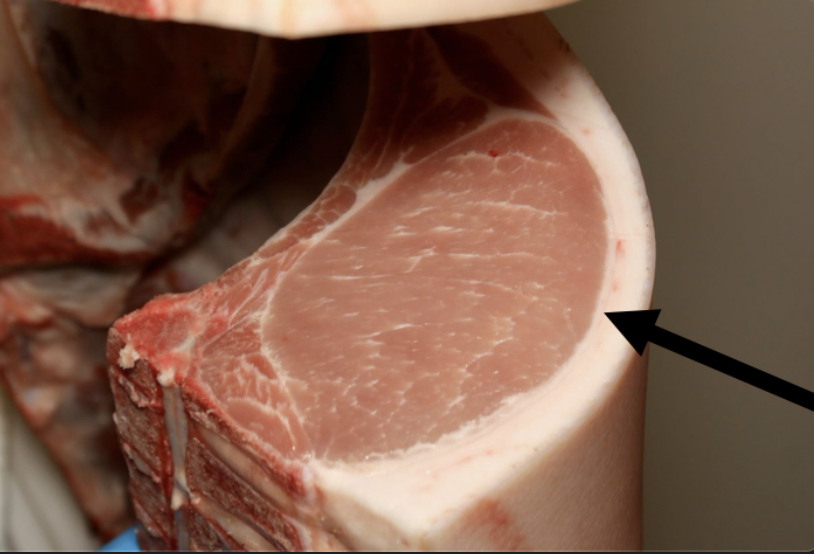
Muscling
LEA
Visual shape of ham, loin, shoulder
HEAVIER muscled carcass is desired
Primal cuts
Ham, loin, belly, boston butt, picnic
Lean cuts
Ham, loin, boston butt, picnic
Pork Carcass Evaluation
Trimness, Muscling, Carcass weight
FFL # equation
9-(22*BF)+(3*LEA)+(0.463*HCW)
Pork Quality factors
Color, marbling, firmness
“Ideal” Pork Quality
Greatest chance of good eating experience is in the middle
Not too dark or light
Not too soft or firm
RED, FIRM, NORMAL
Red (reddish pink) color
Firm texture
Normal water loss
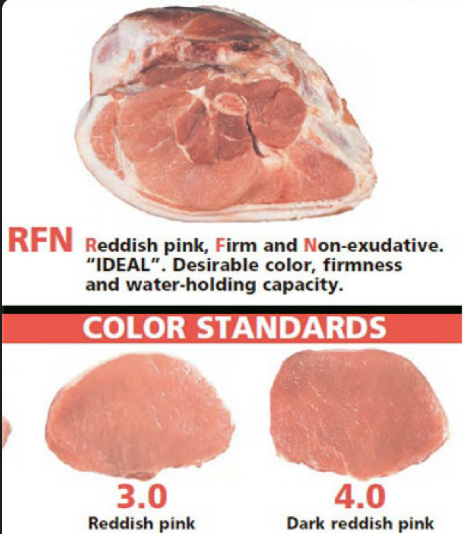
Pork Quality Defects-DARK, FIRM, DRY (DFD)
Dark colored loin eyes not desirable to consumers
Dry and firm to the touch
Sticky surface
High-water holding capacity
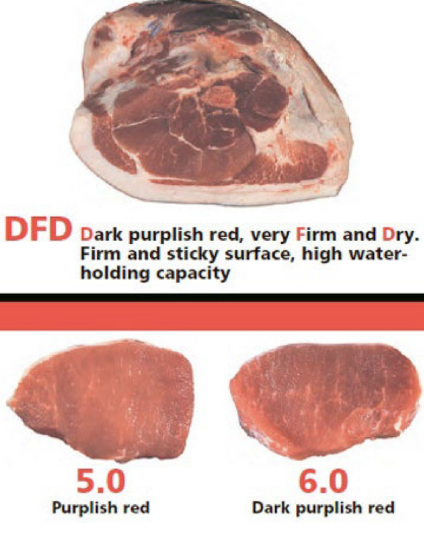
Pork Quality Defects-PSE
Greater concern than DFD
Less desirable product
Low muscle pH
Buildup of lactic acid
Shrinks excessively
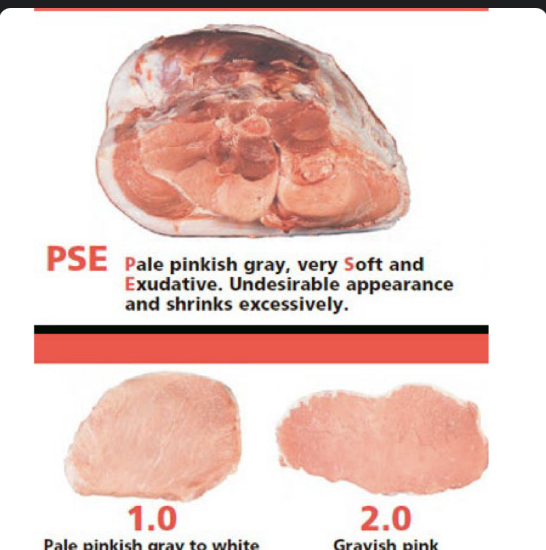
Priorities for evaluating pork carcasses
Trimmer, heavier muscled carcasses are best
Fatter are not preferred
What is evaluated for trimness, muscling, and quality?
LEA and ventral side
How to rank carcasses if they are close on trimness?
Rank on muscle
What is not important for choosing ideal carcasses
Marbling
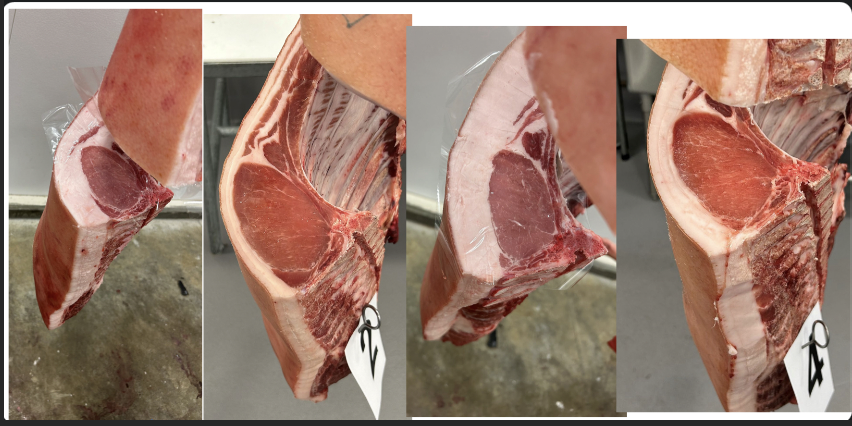
Rank the carcasses
From left to right
4, 1, 3, 2